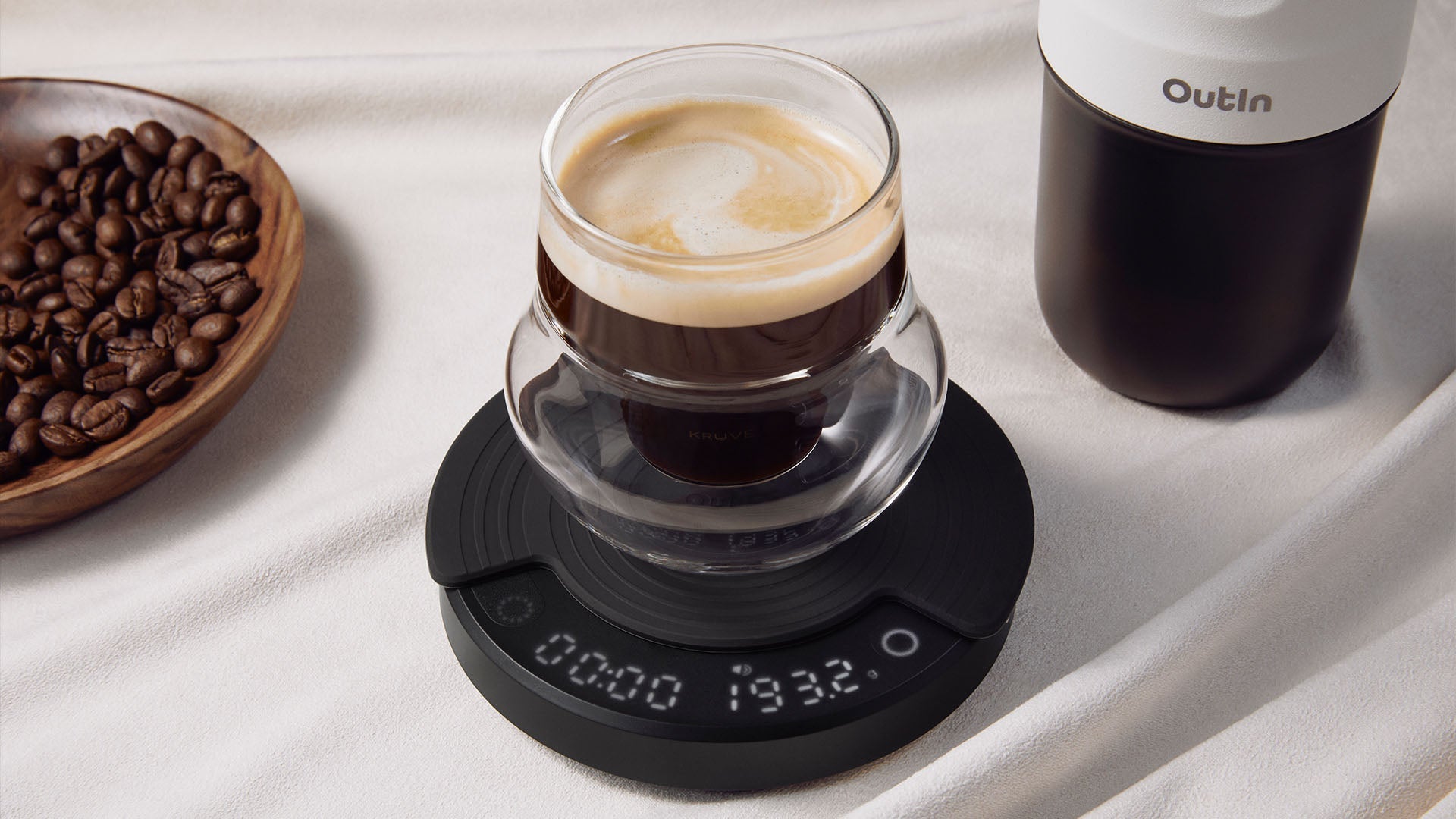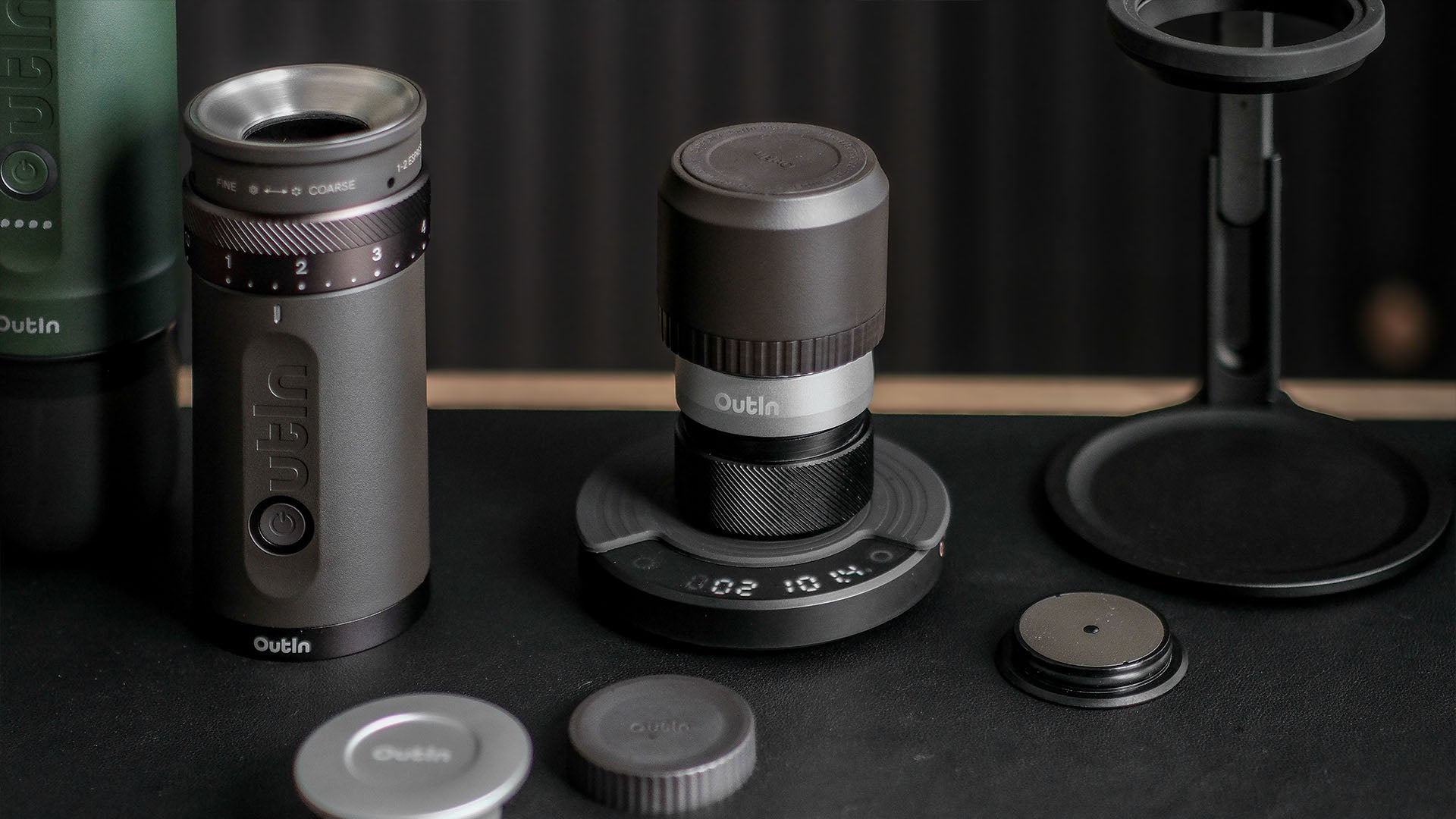Fresh grinding actually does make a difference in the flavor of your coffee. Grinding beans immediately before brewing maintains the flavors lost in pre-ground coffee. A good grinder enables you to control how coarse or fine your coffee is ground, affecting your cup's end flavor. Pre-ground coffee might be convenient, but grinding your own beans produces better coffee with more flavor. That is why choosing the right grinder is a required process for anyone who enjoys good coffee.
OutIn Fino Portable Electric Coffee Grinder
Types of Coffee Grinders
When shopping for a coffee grinder, you'll encounter two main types: burr grinders and blade grinders. Each type works differently and offers distinct advantages and drawbacks.
How They Work
Burr Grinders: These grinders crush coffee beans between two abrasive surfaces called burrs. One burr remains stationary while the other rotates, creating a crushing action that grinds beans to a specific size determined by the distance between the burrs.
Blade Grinders: These use a spinning metal blade to chop coffee beans, much like a small food processor. The blade spins at high speed, cutting the beans into smaller and smaller pieces.
Comparison of Burr vs. Blade Grinders
| Feature | Burr Grinders | Blade Grinders |
| Price | More expensive | Budget-friendly |
| Grind Consistency | Uniform particle size | Inconsistent particles |
| Adjustability | Multiple precise settings | Limited control (timing only) |
| Heat Generation | Minimal | Significant |
| Size & Space | Typically larger | Compact |
| Ease of Use | More settings to learn | Simple one-button operation |
| Cleaning | More complex | Generally easier |
| Durability | Long-lasting | Shorter lifespan |
| Best For | Coffee enthusiasts seeking quality | Casual drinkers on a budget |
This side-by-side comparison should help you determine which type best suits your coffee needs, budget constraints, and available kitchen space before we explore more specific features to consider.

How to Choose the Right Burr Grinder
If you've decided on a burr grinder, several key factors will help you find the perfect match for your coffee needs and budget.
Burr Material: Steel vs. Ceramic
The burrs are the heart of your grinder, and their material affects performance, taste, and durability.
Steel burrs cut through beans quickly and efficiently. They're tough enough for daily use and typically cost less than ceramic alternatives. While they may generate slightly more heat during grinding, good-quality steel burrs rarely affect flavor.
Ceramic burrs run cooler and quieter than steel. They maintain their sharpness exceptionally well but can crack if they encounter a small stone. Their higher price often reflects their longer lifespan.
Quick Tip: For daily use, steel burrs offer the best value. If you're sensitive to noise or grind in large batches, ceramic might be worth the extra cost.
Burr Shape: Conical vs. Flat
| Feature | Conical Burrs | Flat Burrs |
| Design | Cone inside a ring | Two parallel rings |
| Noise Level | Quieter | Louder |
| Grinding Speed | Slower | Faster |
| Heat Generation | Lower | Higher |
| Best For | All-purpose brewing | Espresso focus |
| Price Range | Generally lower | Typically higher |
Both designs can produce excellent results, but conical burrs are more common in home grinders due to their versatility and value.
Grind Consistency: Even Extraction Matters
The most important job of any grinder is creating uniformly sized coffee particles. Consistency matters because:
When grounds vary in size, smaller particles over-extract (causing bitterness) while larger ones under-extract (causing sourness).
Better grinders create more uniform particles, which leads to more balanced extraction and better-tasting coffee. This is the primary advantage of burr grinders over blade models.
Adjustment Mechanism: Stepped vs. Stepless
Most burr grinders offer one of two adjustment systems:
Stepped adjustment provides distinct "click" settings that make it easy to switch between brewing methods and return to your favorite settings. Perfect for households that brew different styles of coffee.
Stepless adjustment allows infinite fine-tuning with no preset positions. This precision is ideal for espresso enthusiasts who need to make tiny adjustments to dial in the perfect shot.
The best system depends on your brewing habits and how much control you want over your grind size.

Grind Size Range: From Espresso to French Press
Different coffee preparations require specific grind sizes:
- Espresso: Very fine (powdered sugar)
- AeroPress/Moka Pot: Fine to medium-fine
- Drip/Pour-over: Medium (regular sand)
- French Press/Cold Brew: Coarse (sea salt)
Before purchasing, check that the grinder can produce the full range of grinds you'll need for your preferred brewing methods.
Buyer's Note: Many budget-friendly burr grinders struggle with consistent espresso-fine grinds. If espresso is your focus, be prepared to invest more.
Motor Quality: Power and Heat Management
A good motor balances power, speed, and heat management. For home use:
- Power: 100-150 watts is sufficient for most households
- Speed: Lower RPM motors generally produce less heat and better results
- Duty cycle: Better grinders can run longer without overheating
Unless you're grinding for large groups, prioritize quality over raw power.
Housing Construction: Frame and Body Materials
A quality grinder should last many years, making durability a worthwhile investment:
- Metal bodies and components generally outlast plastic
- Heavier grinders often contain more metal parts
- Reputable brands typically offer better long-term support
While quality burr grinders cost more initially, their per-cup cost becomes quite reasonable when spread over their lifespan.
Additional Practical Considerations
- Noise Level: If you brew early mornings while others sleep, noise matters. Ceramic burrs and conical designs tend to run quieter.
- Static Buildup: Static makes grounds cling everywhere, creating a mess. Metal components and anti-static features help minimize this.
- A simple trick: Add a drop of water to beans before grinding.
- Cleaning Access: You'll need to clean your grinder regularly. Look for models with removable burrs and easy access to the grinding chamber. Grinders that require special tools or complex disassembly become frustrating over time.
Shopping Guide: Match your grinder to your needs:
- Casual Brewers ($80-150): Conical burrs, steel construction, stepped adjustment
- Coffee Enthusiasts ($200-400): Flat burrs, stepless adjustment, stronger motor
- Espresso Specialists ($300+): Flat burrs, precise microadjustment, metal body

What to Look for When Buying a Blade Grinder
If you've decided on a blade grinder for budget reasons, not all models are created equal. Here are the key factors to evaluate when choosing between different blade grinder options.
Motor Power and Durability
Different blade grinders offer varying motor strengths, which affects how efficiently they can process harder coffee beans. Look for:
- Motors in the 150-200-watt range for better performance
- Models with overheating protection for a longer lifespan
- Grinders with metal motor housing rather than all-plastic construction
A more robust motor will provide more consistent results and better longevity, especially if you grind coffee frequently.
Blade Quality and Design
The blade is the most important element in any blade grinder. Improved models have stainless steel blades that are resistant to dulling and corrosion in the long run. Note the inclination of the cutting surfaces, since well-designed blades produce more effective grinding action. The blade needs to be mounted firmly to avoid loosening over time. Premium models have some with dual blades or custom cutting surfaces that enhance the consistency of grinding, which is the main weakness of this grinder type.
Capacity Considerations
Blade grinders typically come in various sizes:
- Small models grind 1-2 cups worth of coffee (about 30g)
- Medium-sized options handle 3-4 cups (about 60g)
- Larger models can process up to 70-80g of beans at once
Choose a capacity that matches your typical brewing amount to avoid the need for multiple batches.
Safety Features
Essential safety features to look for include:
- Secure locking lids that prevent operation when open
- Non-slip base that keeps the grinder stable during operation
- Clear visibility of the grinding chamber to monitor progress
- Cord storage options to reduce countertop clutter
These safety elements become important during daily use, especially in busy kitchens.
Noise Level Variations
While all blade grinders make noise, the decibel level can vary quite a bit from one model to another. Some features include sound-dampening technology or rubber components that absorb shock vibration when operating. Lower RPM motors typically translate to a quieter grinder without compromising grinding power. If you intend to use your grinder at dawn or share a communal space, checking user reviews for noise level will provide you with an understanding of the models running at more acceptable decibel levels.
Cleaning Accessibility
The ease of cleaning your grinder impacts long-term satisfaction with your purchase. Choose models that offer removable grinding chambers and provide complete access to all parts where coffee grounds may build up. Grinders with smooth interior corners prevent coffee from building up in hard-to-clean areas. Cleaning brushes specific to their models are included with some manufacturers, reducing the time spent on cleaning. Some models now include parts that can be cleaned in a dishwasher, providing another easy option.
Price-Quality Balance
Even within the budget-friendly blade grinder category, prices typically range from $10 to $40:
- Basic models ($10-15) often sacrifice durability and consistency
- Mid-range options ($15-25) typically offer the best value
- Premium blade grinders ($25-40) include better build quality and features
The sweet spot for most users is in the mid-range, where you get reasonable quality without approaching the cost of entry-level burr grinders.
Invest in the Right Coffee Grinder!
A good coffee grinder makes a noticeable difference in your daily brew. Burr grinders provide consistent results and precise control, ideal for coffee aficionados. Blade grinders offer an affordable entry point for daily drinkers. Rank the qualities highest for your intended brewing method and budget. Any grinder is a worthwhile addition to your kitchen since even the simplest fresh grinding enhances flavor.





Leave a comment
This site is protected by hCaptcha and the hCaptcha Privacy Policy and Terms of Service apply.